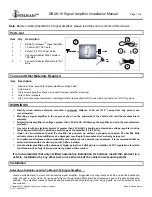
Copyright 2008 JRS Publishing (USA), Inc. Reprinted with permission.
Reprinted from
Pro Audio Review
BENCH TEST
QSC PL380 Power Amplifier
BENCH MEASUREMENT DATA
Maximum Power (1 kHz, 1% THD)
(See Notes)
Stereo 8-ohm loads 1.4 kW, 31.5 dBW
Stereo 4-ohm loads 2.3 kW, 33.6 dBW
Stereo 2-ohm loads 3.0 kW, 34.8 dBW
Bridged 4 ohm load 6.0 kW, 37.8 dBW
Dynamic Output Power
Stereo 8 ohm loads 1.8 kW, 32.6 dBW
Stereo 4 ohm loads 3.6 kW, 35.6 dBW
Stereo 2 ohm loads 6.0 kW, 37.8 dBW
Bridged 4 ohm loads 12.0 kW, 40.8 dBW
Dynamic Headroom
Stereo 8 ohm loads
1.1 dB
Stereo 4 ohm loads
1.9 dB
Stereo 4 ohm loads
3.0 dB
THD+N at near rated power (20 Hz - 20 kHz)
Stereo 8 ohm loads
<0.02% @ 1.0 kW, 20 Hz – 2 kHz
< 0.6% @ 1.0 kW, 20 kHz
Stereo 4 ohm loads
<0.05% @ 1.5 kW, 20 Hz – 2 kHz
< 1.0% @ 1.5 kW, 20 kHz
THD+N at 10W output (20 Hz - 20 kHz)
Stereo 8 ohm loads
< 0.08%
Stereo 4 ohm loads
< 0.1%
Damping Factor, 50 Hz re 8 ohm
206
Output Impedance magnitude at:
50Hz 38.8 milliohm
1 kHz 57.4 milliohm
5 kHz
196.7 milliohm
10 kHz
393.9 milliohm
20 kHz
867.9 milliohm
Input Impedance 14.7 kilohm
Frequency Response, 4-ohm load
20 Hz - 20 kHz +/- 0.0 dB
- 3 dB at < 10 Hz, 58 kHz
Voltage Gain, 8-ohm load, vs. gain setting
26 dB
21.2X, 26.5 dB
32 dB
41.8X, 32.4 dB
1.2V
92.1X, 39.3 dB
Sensitivity for 0 dBW, 8-ohm load
26 dB
133 mv, -15.3 dBu
32 dB
67.7 mv, -21.2 dBu
1.2V
30.7 mv, -28.0 dBu
Sensitivity for rated output, 1.5 kW, 8-ohm
26 dB
5.17 V, 16.5 dBu
32 dB
3.62 V, 13.4 dBu
1.2V
1.12 V, 3.2 dBu
Output noise, 32 dB gain setting, Ch1/Ch2
(essentially gain setting Independent)
Wideband
110/200 mV | -28.2/-23.0 dBW
A - Wtd
816/852 uV | -70.8/-70.4 dBW
Signal to noise ratio re: 1.5 kW into 8
ohm, 32 dB gain setting
A - Wtd 102.4 dB
Channel Separation, 20 Hz - 20 kHz
Ch 1 > 2 , Ch 2 > 1
> 50 dB
Power draw @ idle 153 W, 0.58 PF, 2.2A
Notes:
Unless otherwise noted or implied, all
measurements are made with 8-ohm loads from
the balanced XLR inputs, stereo mode with the
volume set to maximum and gain set for 32 dB.
Both channels driven for all distortion and power
measurements. Measurements made on one
channel are made on channel two.
Power output measurements were limited
by the regulation and resultant voltage drop
under power of my AC supply.
BENCH MEASUREMENT COMMENTARY
The QSC PL380 is one brute of an amplifi-
er! This most powerful of the PL series utilizes
both a switchmode power supply and a Class
D switching power amplifier circuit. This one
definitely exceeded the regulation capacity of
my external AC supply fed from a sub-panel
outside of my lab. My load resistors could
take it for the relatively short time of the dis-
tortion vs. power tests.
Class D amplifiers in general have an out of
band high frequency response that is a func-
tion of load impedance value due to their nec-
essary LC output filters. The PL380 has this
relatively controlled. This is shown in
Fig. 1
for
frequencies greater than 10 kHz and loads of
open circuit, 8, & 4 ohm. Low frequency
response was very extended. This is plotted
in
Fig. 2
along with the response of the two
low-cut filter positions of 30 & 50 Hz.
THD+N for a 1 kHz test signal and for 8,
4, and 2 ohm loading in the stereo mode are
shown in
Fig. 3
. Distortion is reasonably low
and noise dominated up to about 10W and
then begins to rise with 8-ohm loading. The
lower impedance loads cause more distor-
tion above the 10W level which is not sur-
prising. As mentioned above, my AC supply
couldn’t hold the voltage up enough under
this VERY high amperage load to make the
rated power at the lower loads. But still, 3
kW per channel ain’t bad! No doubt the amp
would meet it’s ratings with a maintained
120V AC line input.
Plotting THD+N as a function of frequency
and power for 4 ohm loading, distortion is low
up to about 2 kHz, where it begins to rise and
gets to pretty high values above 10 kHz at the
1.5 kW and higher levels. The 1 & 10W levels
are noise dominated.
The damping factor vs. frequency shows an
unusual, in my experience, increase in DF
below about 50 Hz.
In terms of Channel separation, unusual is
the more or less flat nature of the separation
vs. frequency. Much more usual is a charac-
teristic that rises with frequency due to capac-
itive coupling in the signal circuitry.
— Bascom King
Fig. 1: Frequency response at the 1W/8 ohm
level as a function
Fig. 2: Frequency response of the Low and High
cut filters. Red = Flat, Magenta = 30 Hz low cut,
Blue = 50 Hz low cut
Fig. 3: THD+N of 1 kHz signal vs. power output
for 8, 4, & 2 ohm loading, bottom to top at 100W





















